Bleached or lightened hair can be absolutely gorgeous, but it can also take a lot of time, effort, and money to maintain. If you are reading this article, you have probably grown tired of bleaching your hair and you’re ready for a change. There’s no shame in that!
If you want to repigment your bleached hair, you have come to the right place! This article will help you every step of the way, from choosing your color to caring for your hair afterward. After all, it’s never a good idea to start a chemical process on your hair without being totally informed first.
Coloring your hair with the wrong products and/or methods is a great way to land back in the salon chair for a pricey color correction service.
Repigmenting Bleached Hair
You may be asking, “Why can’t I just go buy some color and slap it on?” Because your hair has been bleached before, there are certain things you need to keep in mind when repigmenting it. But, not to worry! Everything you need to know is at your fingertips.
In this article, we will thoroughly discuss these four steps to repigmenting your bleached hair:
- Choose the Perfect Color
- Prepare Your Hair
- Apply the Hair Color
- Give Your Hair Some TLC
If you follow the suggestions in this article, you will be rocking your gorgeous new hair color in no time!
#1. Choose the Perfect Hair Color to Repigment Your Bleached Hair
This is a critical step in repigmenting your bleached hair. After all, every hair color out there will provide a different result. It may seem overwhelming, but with the information below, you will be able to make an informed decision in order to choose the best hair color for yourself.
Choose the Right Type of Dye
There are several types of hair color or dye on the market, and each type serves a different purpose. Here are the three main types of hair color:
- Semi-Permanent
- Demi-Permanent
- Permanent
To repigment bleached hair, I recommend that you use either a semi-permanent or demi-permanent color, because they are much less damaging to your hair than permanent hair color. Although it is possible to repigment bleached hair with permanent color, it shouldn’t be your first choice.
Because permanent color contains ammonia, it is more damaging to the hair, and the last thing you need to do to your bleached hair is damage it further.
Let’s get to the specifics of semi-permanent and demi-permanent hair color so that you can choose the best option for your hair.
Semi-Permanent

A semi-permanent hair color is one that simply coats the outside of the hair with pigment, without opening up the cuticle, or outside barrier, of the hair. Simply put, semi-permanent hair colors are temporary.
Many times, semi-permanent colors are used for adding vibrant shades to bleached hair, such as pinks, blues, greens, etc. However, they also come in more subtle, natural tones. If you want to simply coat your bleached/lightened hair with a shade that will wash out within a week or two, use a semi-permanent color.
Consider using a semi-permanent hair color to pigment to extremely damaged hair, because it won’t cause any further damage at all. If you don’t think your bleached hair can handle even one more color process, just apply a semi-permanent color.
When you apply a semi-permanent color, you don’t have to use a developer. You simply put the color/dye directly on your hair.
Forms of Semi-Permanent Colors:
- Colored Hair Mask
- Tinted Shampoo
- Tube of Semi-Permanent/Temporary Hair Dye
In this article, the directions given apply to the use of a tube of semi-permanent hair dye. If you are using a colored hair mask or tinted shampoo, simply consult the directions on the bottle/jar.
Demi-Permanent
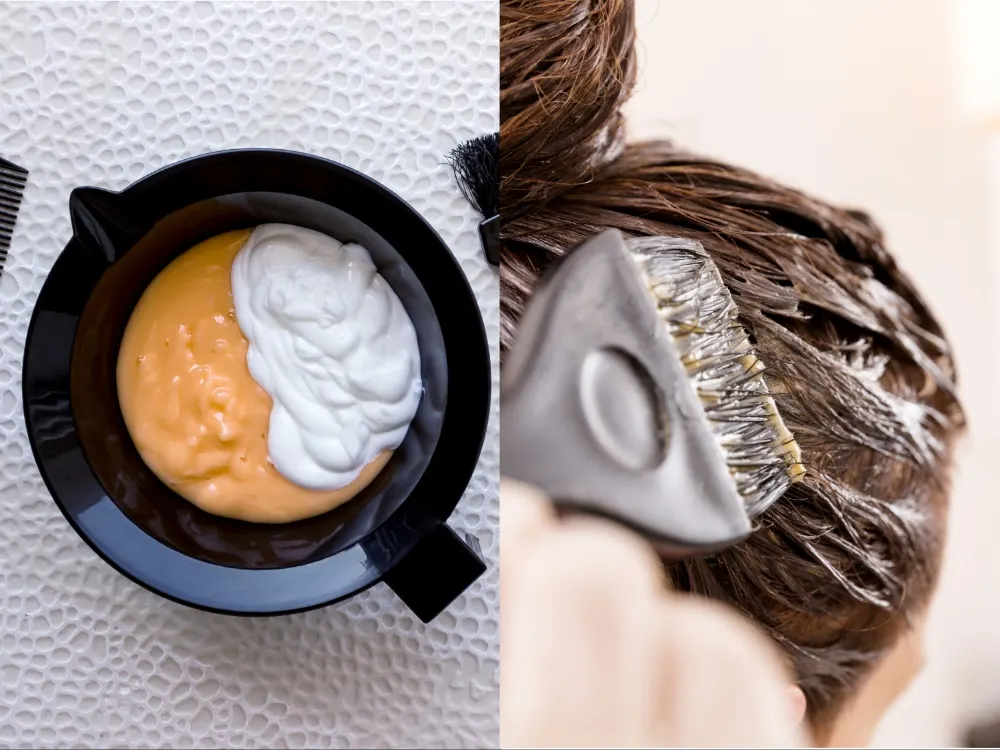
A demi-permanent hair color is one that penetrates the outer cuticle, or barrier of the hair, to deposit color. It doesn’t contain ammonia, so it does not penetrate through the core of the hair and it doesn’t remove any pigment from the hair. It lasts for twenty to twenty-four washes. (That’s at least ten weeks if you wash your hair twice a week.)
Demi-permanent hair colors are basically the middle man between semi-permanent and permanent colors. I personally love to use demi-permanent colors to repigment bleached hair because they deposit color into the hair without the damaging effects of ammonia.
Additionally, the fact that demi-permanent colors don’t lift any color out of the hair works just fine for repigmenting bleached hair. Bleached hair has already had the pigment lifted out of it, so you definitely don’t need to lift out more. A demi-permanent color will simply deposit color under the cuticle of your hair without lifting color or altering the core of each strand of hair.
In order to use a demi-permanent color, you need to mix it with a 5 or 10 volume developer. The developer makes it possible for the color to penetrate the outer cuticle of the hair.
Many hair lines only carry 10 volume developers, and not 5 volume, but either will work. If you want to be extra gentle with your hair, a 5 volume developer is slightly less potent than the 10 volume.
Demi-permanent colors are a great choice if you want to repigment your bleached hair on a long-term basis without causing much damage.
Forms of Demi-Permanent Colors:
- Liquid Color (in a bottle)
- Cream Color (in a tube)
Choose the Right Tone of Hair Color
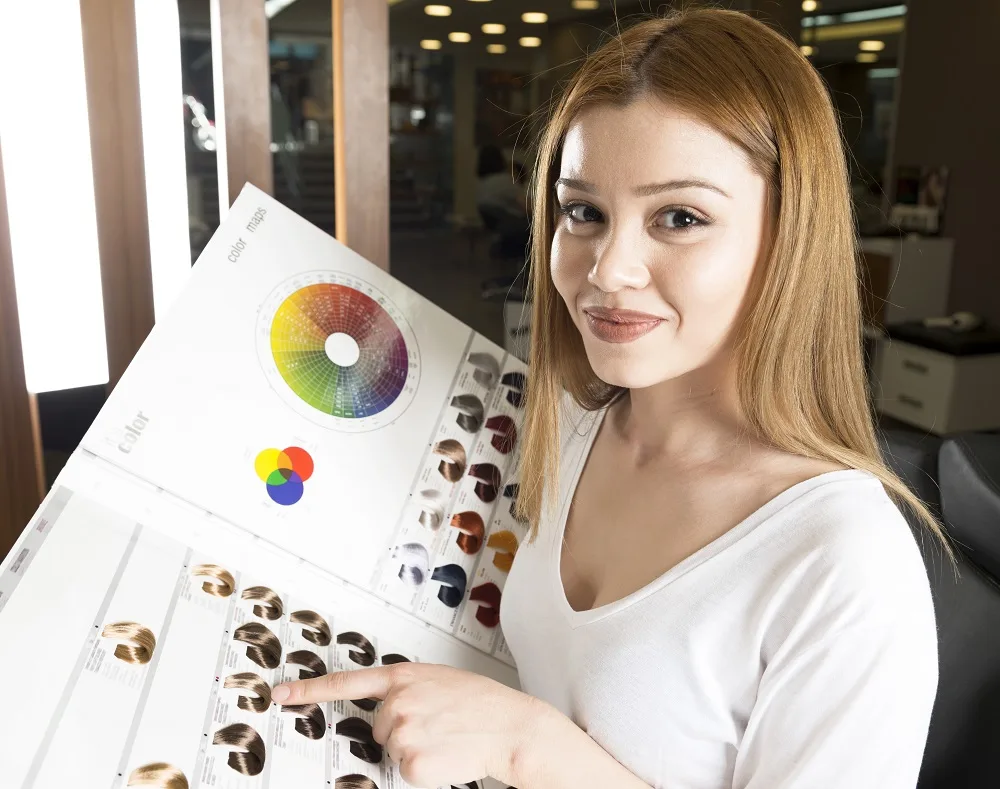
Not only is it important to choose the right type of hair color, but it is also important to choose the correct tone. Because your hair is bleached, it is more porous than non-bleached hair, so it will soak up whatever color you put on it. If you choose the wrong color, you will most likely be stuck with it for a while.
Before you choose your color, it is best to evaluate just what color you are starting from. The picture below depicts what hairstylists refer to as hair color “levels.” Each level is a basic measurement of darkness or depth, level one being the darkest black, and level ten being the lightest blonde. In each level, there are countless variations of tones.
If your hair has been bleached, it is likely on the lighter end of the spectrum. Take a look in the mirror and try to evaluate how dark your hair is. Try to look past the exact tone of your hair (copper, ash, violet, gold) and simply evaluate the level of darkness. Match your level with one of the numbers from 1 to 10.
It is also important to decide what tone of color you want to apply. If you have brassy, yellow bleached hair and want to transform it into a cool brown, you will need to use a neutral or violet-brown color to counteract the copper/yellow in your hair
When choosing a semi-permanent shade to repigment your bleached hair:
Semi-permanent colors are fairly simple to choose, as they usually just come in specific shades, and aren’t categorized into levels.
That being said, if your bleached hair is still a bit on the darker side of the spectrum, a lighter semi-permanent color probably won’t even show up. If you are repigmenting your light, bleached blonde hair, you may be able to use a lighter pigment.
For instance, a light, bubblegum pink will probably not show up on your level 5 hair, but a dark purple or blue might.
If you have platinum blond hair that is closer to a level 10, the bubblegum pink should be perfectly visible.
When choosing a demi-permanent shade to repigment your bleached hair:
The process of choosing a demi-permanent hair color is a bit more involved than choosing a semi-permanent color. When choosing a demi-permanent color, you must decide on both the level and tone of the color. Both of those characteristics will be labeled clearly on the box, tube, or bottle.
As far as the level goes, you need to choose a color that is the same level of your hair or darker. Because demi-permanent color doesn’t lighten your hair, it won’t do you any good to choose a level that is lighter than the level of your hair.
If you want to repigment your bleached hair without darkening it, you simply have to choose a color that matches the level of your hair.
Next, you need to choose the tone of the color, which is usually depicted by a letter combination. The specific tones vary depending on the color line, so you may need to consult a color swatch book for that specific color line in order to pick the correct tone.
As stated earlier, if your goal is to get rid of the brassy/yellow tone of your hair and repigment it to be a cooler, ashy color, it is best to use a color that has a neutral, ash, or violet tone. (Be careful when using ashy colors, as they can become overly green.)
Now that you have chosen your perfect color, it is time to prepare your hair!
#2. Prepare Your Bleached Hair to be Repigmented

Before you get too excited and start applying your new color, it is important to prepare your bleached hair for the repigmentation process. There are a few things you can do to prepare your hair to ensure the best results.
First of all, if your bleached hair is very damaged and you are concerned about damaging it further with a demi-permanent color, you can prepare your hair for the repigmentation process by applying a protein treatment the week before you color it. A protein/keratin treatment will help build up the strength of your hair before you color it.
Follow the steps below to prepare your hair for the repigmentation process:
- Thoroughly cleanse your hair without using a shampoo that contains sulfates. Because your bleached hair is already delicate, it is best to use a mild shampoo that won’t completely strip it of all of its natural oils. If you feel that you need a deeper cleanse, there are clarifying shampoos that contain elements like charcoal or apple cider vinegar rather than sulfates. Make sure that you shampoo your hair more than once to build up a good lather and thoroughly cleanse your hair.
- Detangle your hair with a light conditioner or no conditioner. Don’t let it soak into your hair for too long. You will be applying a deep conditioning treatment to your hair after you color it. Normally, I would say to rinse out the conditioner with cool/cold water, but before you color your hair, you should rinse the conditioner out with warmer hair to avoid sealing down the cuticle of the hair.
- Dry your hair thoroughly (unless you are using a liquid, demi-permanent hair color) either by blow drying it or by letting it air dry. Your hair must be completely dry before you add color. When there is water in your hair, your hair is not able to absorb as much color as it would when it is completely dry.
Note: If you are using a liquid, demi-permanent color to repigment your hair, you will apply it to your damp hair. (Make sure to confirm this by checking the directions.) If that is the case, simply squeeze and pat the excess water out of your hair before applying the liquid demi-permanent color.
#3. Apply the Color to Repigment Your Bleached Hair
At this point, you have purchased your perfect color and prepared your hair to be repigmented. Now it’s time for the fun part: applying the color to your hair. Of course, each different type of color will require different materials and a different method of application.
Below is a table specifying the materials you will need when using each type of hair color.
| Materials | Semi-Permanent Color | Liquid Demi-Permanent Color | Cream Demi-Permanent Color |
|---|---|---|---|
| Gloves | Yes | Yes | Yes |
| Cape/Apron | Yes | Yes | Yes |
| Color Bowl | Yes | No | Yes |
| Color Brush | Yes | No | Yes |
| Liquid Applicator Bottle | No | Yes | No |
| Towels | Yes | Yes | Yes |
| Measuring Cup | No | Yes | Yes |
| Plastic Cap | Yes | Yes | Yes |
| Butterfly Clips | Yes | Yes | Yes |
| Rat Tail Comb | Yes | No | Yes |
| Timer | Yes | Yes | Yes |
After you have all the needed materials, it’s time to mix and apply the color. It is always beneficial to read the directions on the packaging before applying the color. The directions should specify how to mix the color and how long you should leave it on your hair.
Below you will see step-by-step guidelines for applying each different type of color in order to repigment your bleached hair.
How to Apply a Semi-Permanent Hair Color to Repigment Your Bleached Hair
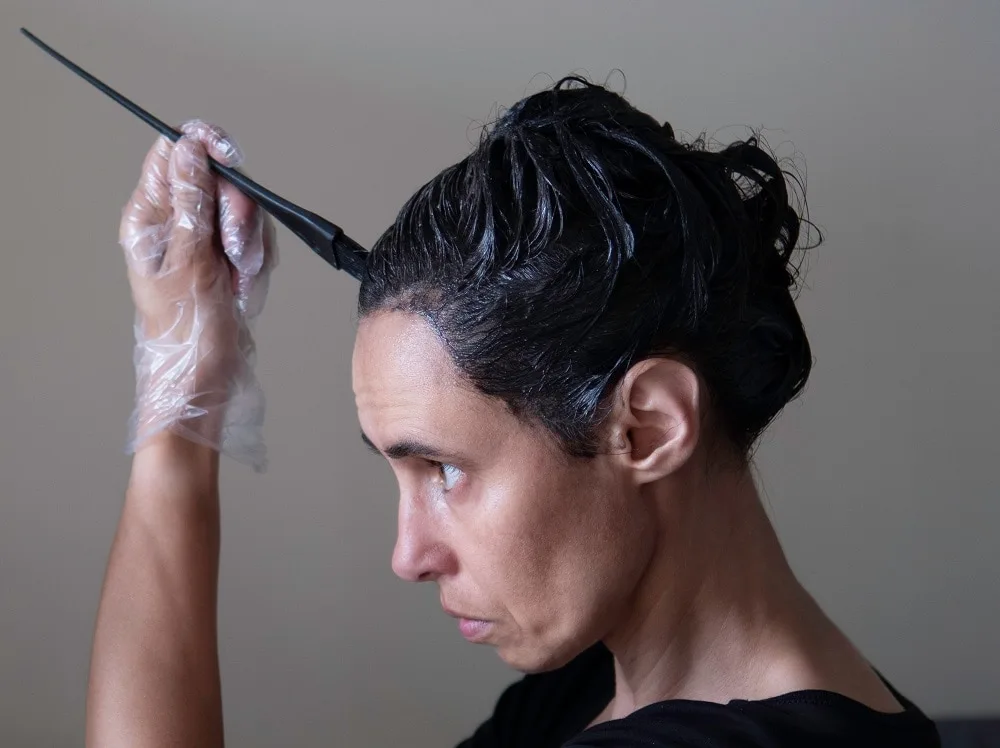
- Put on your cape/apron and gloves.
- Squeeze the tube of semi-permanent color into the color bowl.
- Section your hair into four sections, and clip each section in place with your butterfly clips.
- Dip the color brush into the color and brush it onto the perimeter of your hairline. Then apply the color to the perimeter of each of the four sections of hair.
- Start at the back of your head at the nape of your neck. Use your rat tail comb to section out a small section of hair.
- Brush the color onto your hair, starting at the roots and working your way down to the ends. Use your fingers to squish and rub the color into your hair, fully saturating it with color.
- Work your way to the crown of the head section by section, and then move to the front sections of hair.
- After you have applied the color to your whole head, cover your hair with a plastic cap.
- At this point, you can leave the color on for as long as desired. There may be a recommended processing time on the tube/jar, but if you are using a temporary/semi-permanent color, leaving it on for longer will not damage your hair.
- Shampoo your hair with a gentle shampoo and make sure to let a conditioner soak into your hair for a few minutes. Use cold water to shampoo and condition your hair.
How to Apply a Liquid Demi-Permanent Hair Color to Repigment Your Bleached Hair
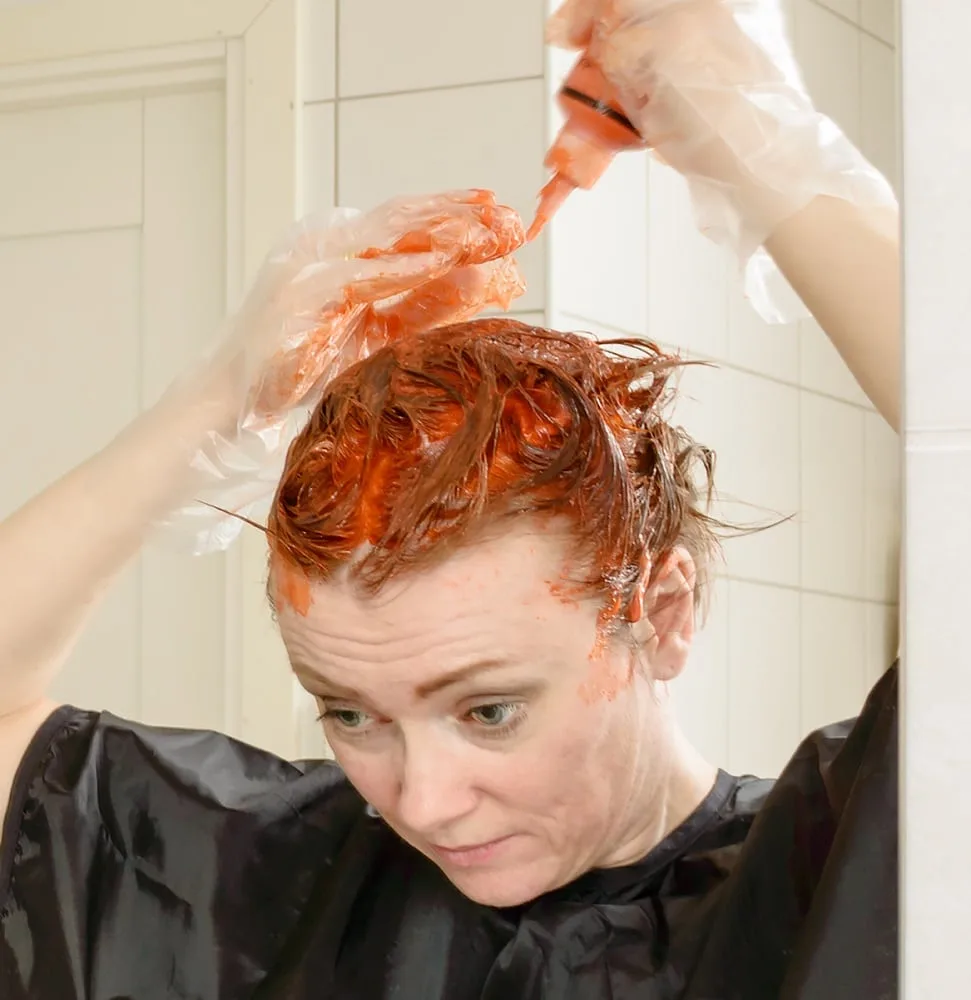
- Put on your cape/apron and gloves.
- Pour the color in an applicator bottle, and then pour in the developer. The directions for the color will specify at what ratio you should mix the color and developer. Usually, color applicator bottles will come with measurements on the side, so you don’t have to use a measuring cup.
- Thoroughly shake the applicator bottle to mix the color with the developer.
- Flip your hair over a sink, shower, or bath tub.
- Squirt the color all over your hair, making sure to saturate your roots.
- Rub the toner in from roots to ends, just as you would a shampoo. Make sure your hair is fully saturated with the color. It may even lather.
- Comb the toner through your hair with a wide-toothed comb or your fingers.
- Cover your hair with a plastic cap to prevent making a mess, and to keep your hair from drying.
- Set your timer for the recommended processing time, which is usually 20 to 30 minutes for liquid demi-permanent colors.
- After your color has been processed for the recommended amount of time, shampoo your hair with a gentle shampoo and make sure to let your conditioner soak into your hair for a few minutes. Use cool water to shampoo and condition your hair.
How to Apply a Cream Demi-Permanent Hair Color to Repigment Your Bleached Hair

- Put on your cape/apron and gloves.
- Squeeze the tube of demi-permanent color into the color bowl.
- Measure the proper amount of developer with your measuring cup. (The ratio of the amount of color to developer that should be used will be specified in the directions for the color.)
- In the color bowl, thoroughly mix the color and the developer.
- Section your hair into four sections, and clip each section in place with your butterfly clips.
- Dip the color brush into the color and brush it onto the perimeter of your hairline. Then apply the color to the perimeter of each of the four sections of hair.
- Start at the back of your head at the nape of your neck. Use your rat tail comb to section out a small section of hair.
- Brush the color onto your hair, starting at the roots and working your way down to the ends. Use your fingers to squish and rub the color into your hair, fully saturating it with color.
- Work your way to the crown of the head section by section, and then move to the front sections of hair.
- After you have applied the color to your whole head, cover your hair with a plastic cap.
- Set your timer for the recommended processing time.
- After your color has processed for the recommended amount of time, shampoo your hair with a gentle shampoo and make sure to let your conditioner soak into your hair for a few minutes. Use cold water to shampoo and condition your hair.
Now that your bleached hair is repigmented, it’s time to give it some extra care!
4. Give Your Repigmented Hair Some TLC
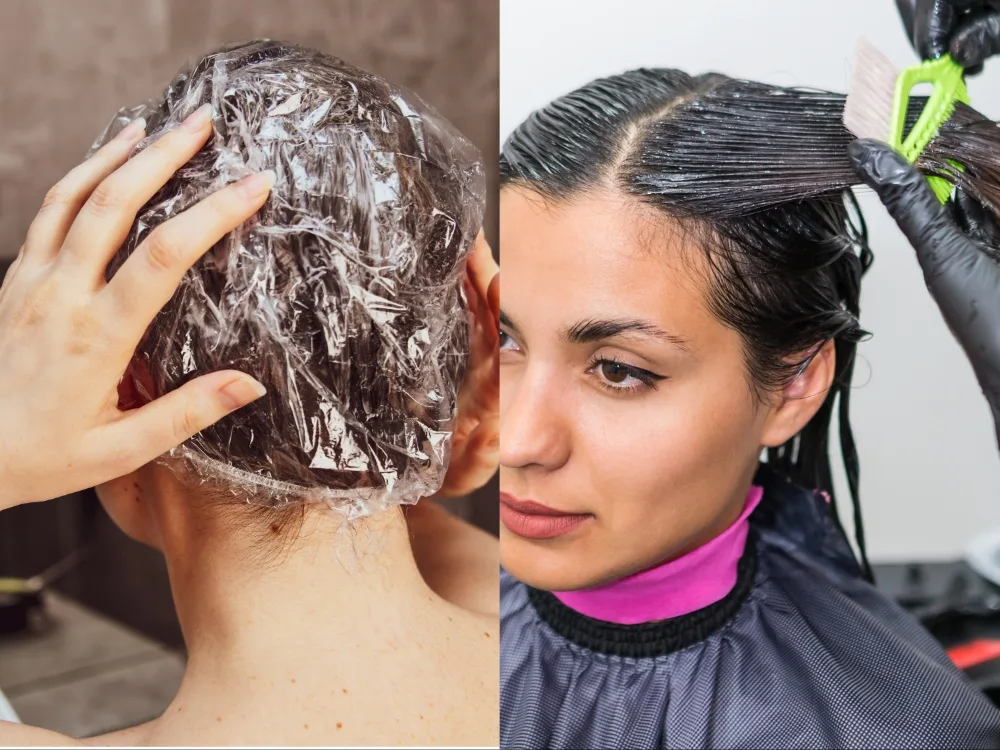
After you have repigmented your hair, it will need some TLC or tender loving care. The truth is, bleaching is one of the most damaging chemical processes hair can go through, and even though you have added color to your bleached hair, the core of the hair is still bleached and damaged.
That’s why it is so important to care for your repigmented hair properly. One of the ways to provide this extra care is by applying regular moisture and protein treatments. These treatments will not only support the health of your hair, but they will also make it look the absolute best.
Here are two of the types of treatments that are beneficial for your repigmented hair:
Moisture Treatments for Your Repigmented Hair
Any chemical process done to hair can have a drying effect. It is so important to add moisture back into your hair to reduce frizz and breakage. Moisture treatments are highly beneficial for maintaining healthy, moisturized hair.
Moisture treatments contain certain oils, humectants, and other substances that hydrate the hair while helping to seal the outside of the hair cuticle. They therefore quench the thirst of your dry, repigmented hair while giving it a smooth, shiny finish.
Protein Treatments for Your Repigmented Hair
Protein treatments strengthen the hair, and are especially important for those who have damaged, colored, or bleached hair. When our hair is chemically processed, the composition of the hair is broken down and altered.
Even though demi-permanent and semi-permanent colors don’t do much damage, you must still remember that your hair has been previously damaged in the bleaching process. By applying protein treatments, you will help your hair rebuild its strength.
There are several different types of protein that you will notice in protein treatments, but the most beneficial, in my opinion, is keratin. Keratin is the protein that naturally occurs in our skin and hair, so it is easily absorbed by the hair and is extremely strengthening.
How Often Should You Use Moisture and Protein Treatments?
For my clients with damaged hair, I recommend alternating moisture and protein treatments every week, so that you will be doing each treatment every two weeks.
However, you may need to experiment to see what is going to work best for your hair. If your hair is looking greasy or weighed down, this may be a sign that the moisture treatment you’re using is too heavy or that you are applying it too often. You may need to balance your hair out with a protein treatment.
Also, keep in mind that it is possible to overdo it with the protein treatments. If your hair is starting to feel dry or a little too “tough,” you may want to balance it out with a moisture treatment.
Your hair will certainly thank you for giving it a little extra TLC!
In Summary
If you are wanting to repigment your bleached hair, you have certainly come to the right place for all the best suggestions. With the right product, method, and aftercare, you can repigment your bleached hair and rock your new hair color with confidence!
Key Things to Know:
- To repigment your bleached hair, use a semi-permanent or demi-permanent hair color.
- A semi-permanent color lasts for 4-6 weeks, while a demi-permanent hair color lasts for at least 8-10 weeks.
- Prepare your hair for repigmentation (with semi-permanent or cream demi-permanent color) by cleansing and drying it thoroughly.
- Apply a liquid demi-permanent color to clean, damp hair.
- Regularly apply moisture and protein treatments after you have repigmented your bleached hair in order to maintain the health of your hair.
